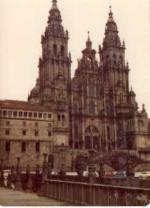

|
Galicia, host to the end of the earth, FinisterreGalicia has some of the most beautiful coastline and beaches in all Spain. Yet it is far less known than the Mediterranean coast, due to the more temperate and moist climate. Part of this coastline, known as the 'Death Coast', is also infamous for its many shipwrecks. However, the world's oldest surviving lighthouse, the Tower of Hercules, a Roman structure, still aids ships entering the port of A Coruña - now a World Heritage Site.Much moister than the rest of Spain, it is known in the country as the producer of much of our milk. The capital, Santiago, is famous for the pilgrimage route, established in the Middle Ages at a time when it was impossible to reach Jerusalem, due to the Crusades. Even today, many pilgrims and walkers dedicate their holidays to walk all or part of the great route across the north of Spain. Government web site Population 1/2008: 2,783,100 of whom 95,122 (3.4%) are foreigners The ChurchesThe origins of the evangelical movement in Galicia can be found in Brethren missionaries from Britain in the late 19th century. To this day the Open Brethren are particularly strong in the region. Membership: (PTL 1997) 5,428 List of churches Some of the best established evangelical churches of Spain can be found in towns dotting the coastal regions of Galicia. British missionaries from the Plymouth Brethren arrived here in the late nineteenth century and began the work of planting churches which have survived strong -but very conservative- to this day. On the other hand, the number of significantly sized villages with no evangelical church is alarming. One of the problems with church planting in Galicia is the nature of municipalities. Many villages have only a few houses in the kernel, close to Catholic church and local shop. The remainder of the population live widely spread out in farm houses. This is a completely different cultural setting to the towns of the Castilian Meseta, where houses are closely packed and the countryside was traditionally totally uninhabited. |
